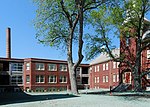Foxborough Pumping Station
Buildings and structures in Foxborough, MassachusettsHistoric districts in Norfolk County, MassachusettsHistoric districts on the National Register of Historic Places in MassachusettsInfrastructure completed in 1891NRHP infobox with nocat ... and 4 more
National Register of Historic Places in Norfolk County, MassachusettsUse mdy dates from August 2023Water supply infrastructure in MassachusettsWater supply pumping stations on the National Register of Historic Places

The Foxborough Pumping Station is a historic water pumping station at 25 Pumping Station Road in Foxborough, Massachusetts. Its main pumphouse was designed by Ernest N. Boyden, a regionally known architect of water supply systems, and was built in 1891; it is a brick structure with Queen Anne styling. The station also includes several historic wells, a period garage, and the man-made Fales Pond, a once-dammed section of the Neponset Reservoir near the pumphouse. The station was listed on the National Register of Historic Places in 2005.
Excerpt from the Wikipedia article Foxborough Pumping Station (License: CC BY-SA 3.0, Authors, Images).Foxborough Pumping Station
Pumping Station Road,
Geographical coordinates (GPS) Address External links Nearby Places Show on map
Geographical coordinates (GPS)
| Latitude | Longitude |
|---|---|
| N 42.077777777778 ° | E -71.238333333333 ° |
Address
Pumping Station Road 25
02035
Massachusetts, United States
Open on Google Maps










